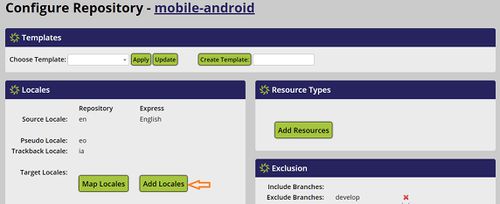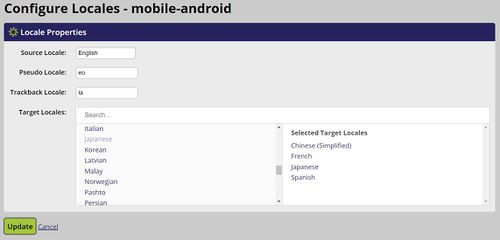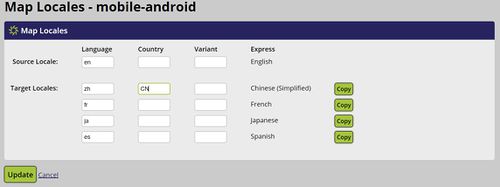Difference between revisions of "Localyzer Express Repository Configuration"
(→Map the locales) |
(→Set the locales) |
||
| Line 16: | Line 16: | ||
= Set the locales = |
= Set the locales = |
||
| + | |||
| + | To check the files in the repository, click the repository name. In the image below, clicking mobile-android will take you to the repository. |
||
| + | |||
* Click Add Locale as shown below: |
* Click Add Locale as shown below: |
||
Revision as of 21:24, 18 November 2020
Before resource files can be translated using Localyzer Express, each repository needs to be configured and validated. The configuration needs to have at least one source locale, one target locale, one resource file type, and one allowed branch.
Contents
- Click on the Repository menu item on the left side menu to go to the Repository page
The repositories for your organizations are listed. You can search for a repository using the Search entry field.
Repositories with the orange circle have not been configured; a green circle indicates a configured repository. For example, in the image above, the marktext has not been configured, mobile-android has been configured.
- Click on the repository name to go to the configuration page for that repository
If templates have been set up, you may select one and apply the template to configure your repository. For more information on templates, see Localyzer Express Templates.
Set the locales
To check the files in the repository, click the repository name. In the image below, clicking mobile-android will take you to the repository.
- Click Add Locale as shown below:
A locale is a language and optionally a region and a variant. The source locale is used by developers to write their application, for example in U.S. English. Target locales are the locales in which the resource files will be translated, for example Spanish, Chinese, Japanese, French.
Resource files are identified in the repository in many ways. For example
- a directory above resource files may be a locale, like en-US for English
- the file names may include the locale, for example resources_fr.properties for French
The locale configuration must address the repository locale notation.
Set the source locale
Pick the source locale using the drop down. The example above shows 'English' as the source locale.
Set the pseudo-locale and the trackback locale
Best is to leave the default as they are. Localyzer will not use these locales for translation.
Select target locales
- Click on a locale in the the left panel to add it to the selected locales
- Click on a locale in the right panel to remove it from the selected locales
- Click Update to finalize the selection and go back to the main configuration page for the repository.
In the example above, Chinese, French, Japanese, and Spanish are selected target locales.
Map the locales
The locale notation for the resource files in the repository varies. For instance, the Chinese target file for 'resources.properties' may be specified:
- resources_zh.properties
- resources_zh_CN.properties
- resources_zh_Hans.properties
The mapping for each locales must correspond to the way the application expects to retrieve the resources.
- Click on Map Locale
- For each locale, indicate how the language, region, and variant are specified in the repository
Above, French is expected to be specified with fr, Chinese with zh and CN.
- Click Update to save the mapping




